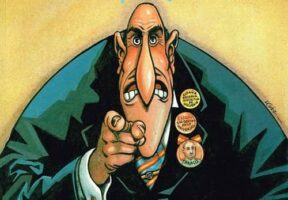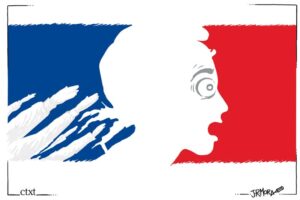
Cover of issue 1178 of Charlie Hebdo (14/01/2015) with drawing by Rénald Luzier "Luz", the first after the attack on 7 January.
"On 7 January 2015, two brothers, Chérif and Saïd Kouachi, entered the headquarters of the satirical weekly Charlie Hebdo in Paris and murdered twelve people. Eight of them were editorial staff: five cartoonists (Wolinski, Cabu, Honoré, Tignous and Charb, the editor-in-chief), a proofreader (Mustapha Ourrad), a psychoanalyst (Elsa Cayat) and an anti-neoliberal economist (Bernard Maris, known as "Oncle Bernard")
The other victims were a journalist, guest of the weekly, Michel Renaud, an elite policeman and Charb's bodyguard, Franck Brinsolaro, the (Muslim) policeman Ahmed Merabet and an employee of a maintenance company, Frédéric Boisseau. At the same time, an accomplice of the Kouachi brothers, Amedy Coulibaly, executed a municipal policewoman, Clarissa Jean-Philippe, on the 8th and four Jewish people in a Kosher supermarket (Yohan Cohen, Yohav Hattab, François Michel Saada, Philippe Braham) on the 9th, before the police killed the three perpetrators of the massacres
On 11 January, numerous republican marches brought together some 3.7 million people in various French cities. On the 14th, Al Qaeda in the Arabian Peninsula (AQPA) claimed responsibility for the attack on the 7th".
So begins the article "To Be/Not to Be Charlie: Immediate Aftermath on the Net" by Isabelle Touton, professor in the Department of Spanish, Spanish-American and Mediterranean Studies at the University of Bordeaux Montaigne (France), an interesting 26-page text published in Marco Kunz 's book " Catastrophe and Violence, Historical Event, Politics and Cultural Productivity in the Hispanic World" by the academic publishing house LIT Verlag (Germany)

Vignette of 7 January 2015
Touton reviews chronologically the immediate and massive online reactions and the birth of the symbolism associated with what became known worldwide as"Je Suis Charlie". He also analyses some of the graphic humour cartoons, many of them by Spanish authors, that were drawn during those days, the different approaches to the attack in these images and the role of satire in the face of terrorism.
It also delves into the gap that separated supporters and opponents of the "Je suis Charlie" slogan and the new meaning that this slogan acquired outside France.

Cartoon of 8 January 2015
![]() To be/not to be Charlie : immediate aftermath on the net, in Marco Kunz's (ed) book, Catastrophe and violence. Violent events, politics and cultural productivity in the Hispanic world, Zurich, Lit Verlag, 2017. (Read on Academia.edu) -(Local download)
To be/not to be Charlie : immediate aftermath on the net, in Marco Kunz's (ed) book, Catastrophe and violence. Violent events, politics and cultural productivity in the Hispanic world, Zurich, Lit Verlag, 2017. (Read on Academia.edu) -(Local download)
![]() do you want to receive new blog posts in your inbox when they are published?
do you want to receive new blog posts in your inbox when they are published?







